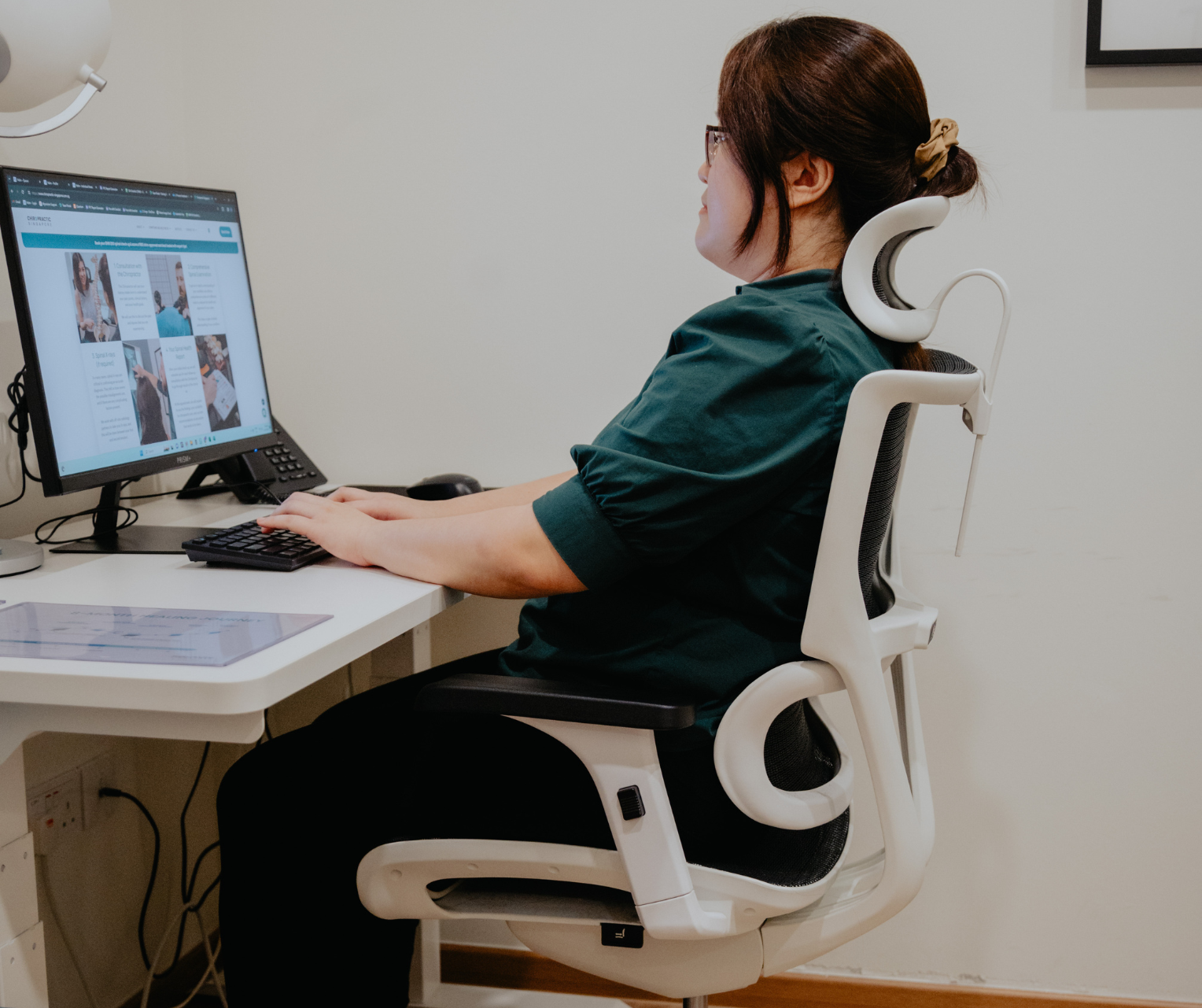A comfortable and supportive study chair is essential for maintaining good posture, preventing chronic pain, and promoting overall well-being in the workplace. Many professionals spend long hours sitting, which can lead to musculoskeletal issues, decreased productivity, and even stress. Pairing the right ergonomic chair with chiropractic care can significantly improve spinal health, boost focus, and create a more positive work environment.
Features of an Ideal Study Chair
- Adjustable Seat Height – Ensures feet rest flat on the floor, promoting better circulation and reducing leg fatigue.
- Lumbar Support – Maintains the natural curve of the lower back to prevent slouching and spinal misalignment.
- Armrests – Reduces strain on shoulders and arms, preventing tension build-up.
- Tilt Mechanism – Allows for slight reclining to relieve pressure on the spine and enhance comfort.
- Breathable Material – Enhances comfort during long hours of sitting, preventing overheating and discomfort
The Importance of a Study Chair in the Workplace

Spending long hours in an improper chair can take a serious toll on your body, leading to discomfort, pain, and even long-term health issues. Poor posture, lack of support, and prolonged sitting can contribute to musculoskeletal strain, nerve compression, and poor circulation. Over time, this can result in chronic conditions such as lower back pain, neck stiffness, sciatica, and poor blood flow to the legs, affecting both productivity and overall well-being.
However, with the right ergonomic chair and proper sitting habits, you can significantly reduce these risks. A well-designed chair that supports the spine’s natural curvature, combined with small posture adjustments, can make a huge difference in how you feel throughout the day.
Understanding the best sitting positions for common issues like back pain, neck stiffness, and sciatica can help you maintain better posture, enhance comfort, and improve your quality of life—whether you’re working at a desk, studying, or even relaxing at home.
Best Sitting Position for Back Pain and Spinal Misalignment
Back pain is one of the most common complaints among individuals who sit for long hours. An unsupportive chair or poor posture forces the spine into unnatural positions, leading to postural misalignment, disc compression, and muscle fatigue. Over time, this can result in chronic lower back pain, stiffness, and increased risk of spinal disorders.
To maintain proper spinal alignment and alleviate back pain:
✔️ Sit with your back fully supported by the chair’s backrest. Ideally, the chair should have lumbar support that follows the natural curve of your lower back. If your chair lacks lumbar support, consider using a lumbar cushion or rolled-up towel for added comfort.
✔️ Keep feet flat on the floor or on a footrest to promote proper weight distribution. Dangling feet can strain the lower back, while tucking them under the chair can increase pressure on the knees.
✔️ Adjust the chair’s height so that your knees are at a 90-degree angle. This position minimises stress on the lower back and prevents excessive pressure on the thighs.
✔️ Avoid prolonged sitting without movement. Even with the perfect posture, staying in the same position for too long can cause stiffness and reduced circulation. Stand up, stretch, or walk around for a few minutes every 30 to 60 minutes to relieve tension and keep muscles active.
Best Sitting Position for Neck and Shoulder Stiffness
If you often experience neck and shoulder pain, tension headaches, or stiffness, it may be due to improper screen positioning or slouching. Hunching forward or sitting too low can strain the cervical spine (neck area) and shoulder muscles, leading to discomfort and reduced mobility.
To prevent neck and shoulder pain:
✔️ Keep your screen at eye level to prevent looking down or tilting your head forward. Your monitor should be positioned directly in front of you at a comfortable viewing distance, with the top of the screen at or slightly below eye level.
✔️ Relax your shoulders and keep elbows at a 90-degree angle. Your arms should rest naturally at your sides without tension. Using an adjustable chair with armrests can help support your arms, reducing strain on the shoulders and neck.
✔️ Ensure your keyboard and mouse are positioned correctly. If they are too far away, you may subconsciously lean forward, leading to muscle fatigue. Your keyboard should be at elbow height, and your wrists should remain in a neutral position while typing.
✔️ Take breaks to stretch your neck and shoulders. Every hour, take a moment to gently roll your shoulders, tilt your head side to side, and do light stretching to relieve stiffness and improve flexibility.
Best Sitting Position for Sciatica and Nerve Compression
Sciatica is a condition where the sciatic nerve—the longest nerve in the body—becomes compressed or irritated, causing pain, numbness, or tingling that radiates from the lower back down the legs. Sitting for extended periods, especially with poor posture, can increase pressure on the sciatic nerve and worsen symptoms.
To reduce pressure on the sciatic nerve and prevent discomfort:
✔️ Sit with hips slightly higher than your knees. This position helps open up the hip angle, reducing pressure on the lower back and preventing excessive strain on the sciatic nerve.
✔️ Use a seat cushion or lumbar support to maintain the spine’s natural curve and prevent excessive pressure on the lower back. A wedge cushion can help tilt the pelvis forward slightly, promoting better posture.
✔️ Avoid crossing your legs. While it may feel comfortable initially, crossing your legs can restrict circulation and place uneven pressure on the spine and nerves, aggravating sciatic pain. Instead, keep both feet flat on the floor or use a footrest.
✔️ Shift your weight and change positions frequently. Sitting in one fixed position for too long can compress nerves and lead to stiffness. Alternate between sitting and standing, and try using a sit-stand desk if available.
How a Study Chair Supports Workplace Well-Being
A well-designed study chair provides essential support to reduce strain, improve posture, and enhance overall workplace well-being. Here’s how the right chair can positively impact your daily work routine.

1. A Good Study Chair can Reduce the Risk of Chronic Pain
A well-designed chair alleviates pressure on the lower back, reducing the risk of discomfort and musculoskeletal strain. Proper lumbar support and an adjustable seat help maintain a neutral spine position, preventing tension build-up and promoting long-term spinal health.
2. A Good Study Chair can Boost Productivity and Focus
Discomfort from poor seating can lead to fatigue and reduced concentration. An ergonomic chair enhances comfort, allowing employees to stay focused and productive throughout the day. By minimising distractions caused by backaches and muscle strain, a supportive chair contributes to improved efficiency and work performance.
3. A Good Study Chair can Promote Good Posture
Using a study chair encourages proper spinal alignment, reducing the risk of posture-related issues that could lead to long-term health concerns. By supporting the spine’s natural curvature and promoting healthy sitting habits, these chairs help prevent work-related musculoskeletal discomfort.
How to Maintain Spinal Health Beyond a Good Study Chair
While a well-designed study chair is essential for supporting your spine during long hours of sitting, maintaining spinal health also requires a holistic approach. Regular movement, stretching, and strengthening exercises are key to preventing stiffness and muscle imbalances. Additionally, chiropractic care is an effective solution for addressing spinal misalignments, relieving muscle tension, and preventing pain. Chiropractors can provide tailored adjustments to keep the spine in optimal alignment, ensuring long-term health and comfort.

How Chiropractic Care Complements a Good Study Chair
While an ergonomic chair is essential for promoting good posture and comfort, pairing it with chiropractic care enhances long-term spinal health and overall well-being. Chiropractors focus on correcting spinal misalignments, relieving muscle tension, and preventing chronic pain associated with prolonged sitting. Regular adjustments help improve flexibility, reduce discomfort, and prevent injuries that can arise from poor posture or sitting for extended periods.
By combining ergonomic seating with chiropractic care, you ensure not only immediate relief but also sustainable health and improved productivity in the long run.
Benefits of Chiropractic Care for Workplace Health
1. Alleviates Back and Neck Pain
Sitting for extended periods, even in the best chair, can cause stiffness and discomfort. Chiropractic adjustments help realign the spine, reducing tension and preventing musculoskeletal issues, allowing employees to feel more comfortable and perform at their best.
2. Improves Posture and Spinal Alignment
Many office workers develop poor posture over time due to incorrect sitting habits. Regular chiropractic care corrects misalignments and strengthens posture, enhancing the benefits of an ergonomic chair. Chiropractors can also recommend personalised posture exercises to complement the use of a study chair.
3. Boosts Energy and Reduces Stress
Chiropractic adjustments improve circulation and nerve function, leading to increased energy levels and reduced workplace stress. Proper spinal alignment allows the body to function more efficiently, reducing fatigue and promoting overall well-being.
4. Enhances Workplace Ergonomics
Chiropractors can assess individual needs and recommend the best study chair and sitting practices for long-term comfort and productivity. By addressing each person’s unique spinal health concerns, chiropractic care ensures a more sustainable approach to workplace ergonomics.
Improve Your Workplace Comfort with Chiropractic Singapore

If you want to enhance workplace comfort, boost productivity, and promote spinal health, Chiropractic Singapore offers expert chiropractic care tailored to office workers & professionals. Our services help relieve pain, improve posture, and ensure you get the most out of your study chair and workplace ergonomics.
Why Choose Chiropractic Singapore?
- Experienced Professionals – Our chiropractors specialise in workplace wellness and spinal health, ensuring expert care.
- Holistic Approach – We focus on treating the root cause of discomfort, not just the symptoms, promoting long-term relief.
- Personalised Care – Every care plan is customised based on individual needs, ensuring the best possible results.
- Convenient Locations – Ideal for working professionals seeking effective chiropractic solutions without disrupting their busy schedules.
Take the First Step Towards Workplace Wellness
Your chair plays a vital role in your health, but chiropractic care ensures long-term well-being. If you experience discomfort, stress, or posture-related issues, visit us today for a consultation and take the first step towards a healthier, more comfortable workplace.
Book your appointment now and experience the difference chiropractic care can make in transforming your work environment!











